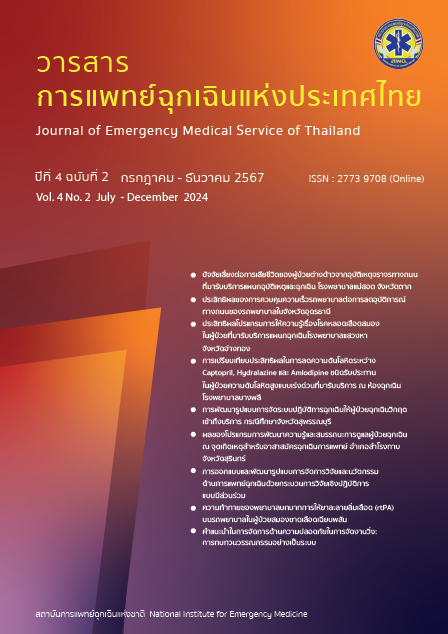A Prospective Observational Study Comparing Oral Captopril, Hydralazine, and Amlodipine in Patients With Hypertensive Urgency at the Emergency Room at Bangplee Hospital
Keywords:
severe asymptomatic hypertension, oral antihypertensive drug, major adverse cardiovascular eventsAbstract
Hypertensive urgency is a common problem, and inappropriate treatment can lead to major adverse cardiovascular events (MACE). Oral antihypertensive drugs, which are available in various types and mechanisms, are the primary treatment. The objective of this study was to evaluate the effectiveness of reducing blood pressure between oral captopril, hydralazine, and amlodipine in patients with hypertensive urgency. This was a prospective observational study collected data from patients in the emergency room of Bangpli Hospital between June 1, 2023, and May 31, 2024. By the purposive sampling, Patients diagnosed with hypertensive urgency received oral captopril (25 mg), hydralazine (25 mg), or amlodipine (10 mg) based on the physician's decision. Blood pressure was recorded every 30 minutes for up to 60 minutes, and patients were followed up for MACE occurrence within 30 days. The effects of blood pressure reduction and complications between the three oral antihypertensive groups were analyzed using multivariable Gaussian regression for correlated data. Results were presented as means and risk differences. The study included 105 participants, the majority were female (56.2%), with an average age of 61.0 years (standard deviation of 15.0 years). The systolic blood pressure (SBP), diastolic blood pressure (DBP), and mean arterial pressure (MAP) reductions at 60 minutes were 28.8±19.4, 16.9±16.5, and 24.0±14.1 mmHg, respectively, across the groups. Hydralazine was more effective in reducing DBP and MAP compared to amlodipine, with mean differences of -9.84 mmHg and -6.87 mmHg, respectively. No significant differences were observed between captopril and amlodipine. The incidence of MACE was not significantly different between the three groups. In conclusion, all three groups effectively reduced blood pressure, with hydralazine showing the greatest efficacy among them.
References
กระทรวงสาธารณสุข [อินเทอร์เน็ต]. นนทบุรี: สำนักงาน; c2024 [สืบค้นเมื่อ 13 ส.ค. 2567]. แหล่งข้อมูล: https://hdcservice.moph.go.th/hdc/reports/report.php?source=pformated/format1.php&cat_id=6a1fdf282fd28180eed7d1cfe0155e11&id=29eec762c9591d1f8092da14c7462361
Williams B, Mancia G, Spiering W, Agabiti Rosei E, Azizi M, Burnier M, et aI. 2018 ESC/ESH Guidelines for the management of arterial hypertension. Eur Heart J 2018;39(33):3021-104.
Vlcek M, Bur A, Woisetschlager C, Herkner H, Laggner AN, Hirschl MM. Association between hypertensive urgencies and subsequent cardiovascular event in patients with hypertension. J Hypertens 2008;26(4):657-62.
O'Mailia JJ, Sander GE, Giles TD. Nifedipine- associated myocardial ischemia or infarction in the treatment of hypertensive urgencies. Ann Intern Med 1987;107(2):185-6.
Grossman E, Messerli FH, Grodzicki T, Kowey P. Should a moratorium be placed on sublingual nifedipine capsules given for hypertensive emergencies and pseudoemergencies? JAMA 1996;276(16):1328-31.
Narotam PK, Puri V, Roberts JM, Taylon C, Vora Y, Nathoo N. Management of hypertensive emergencies in acute brain disease: evaluation of the treatment effects of intravenous nicardipine on cerebral oxygenation. J Neurosurg 2008;109(6):1065-74.
Peixoto AJ. Acute Severe Hypertension. N Engl J Med 2019;381(19):1843-1852.
Sruamsiri K, Chenthanakij B, Wittayachamnankul B. Management of patients with severe hypertension in emergency department, Maharaj Nakorn Chiang Mai hospital. J Med Assoc Thai 2014;97(9):917–22.
Promyuang P. Comparing the efficacy of antihypertensive drug between captopril (25 mg) and hydralazine (25 mg) in patients with hypertensive urgency in emergency department, Chiangraiprachanukroh hospital. CRMJ 2022;14(1):17-30.
Iqbal AM, Jamal SF. Essential Hypertension. In: StatPearls [Internet]. Treasure Island (FL): StatPearls Publishing; 2024 [updated 2023 Jul 20; cited 2023 Feb 14]. Available from: https://www.ncbi.nlm.nih.gov/books/NBK539859/
Tackling G, Borhade MB. Hypertensive Heart Disease. In: StatPearls [Internet]. Treasure Island (FL): StatPearls Publishing; 2024 [cited 2023 Feb 14]. Available from: https://www.ncbi.nlm.nih.gov/books/NBK539800/
Jackson RE, Bellamy MC. Antihypertensive drugs. BJA Education 2015;15(6):280-5.
IBM Micromedex® web application access [Internet]. Colorado: IBM Watson Health; 2022 [cited 2022 Feb 14]. Available from: https://www.micromedexsolutions.com/home/dispath/ssl/true
McComb MN, Chao JY, Ng TM. Direct Vasodilators and Sympatholytic Agents. J Cardiovasc Pharmacol Ther 2016 Jan;21:3-19.
Kessler CS, Joudeh Y. Evaluation and treatment of severe asymptomatic hypertension. Am Fam Physician 2010;81(4):470–6.
Adebayo O, Rogers RL. Hypertensive emergencies in the emergency department. Emerg Med Clin North Am 2015;33(3):539-51.
Campos CL, Herring CT, Ali AN, Jones DN, Wofford JL, Caine AL, et al. Pharmacologic Treatment of Hypertensive Urgency in the Outpatient Setting: A Systematic Review. J Gen Intern Med 2018;33(4):539-50.
Nakprasert P, Musikatavorn K, Rojanasarntikul D, Nara-jeenron K, Puttaphaisan P, Lumlertgul S. Effect of pre-discharge blood pressure on follow-up outcomes in patients with severe hypertension in the ED. Am J Emerg Med 2016;34(5):834-9.
Downloads
Published
How to Cite
Issue
Section
License
Copyright (c) 2024 Journal of Emergency Medical Services of Thailand

This work is licensed under a Creative Commons Attribution-NonCommercial-NoDerivatives 4.0 International License.






